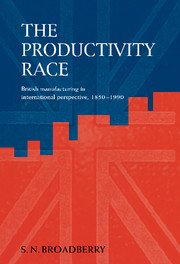Book contents
- Frontmatter
- Contents
- List of figures
- List of tables
- Acknowledgements
- Glossary of terms and company names
- 1 Introduction and overview
- Part 1 measuring comparative productivity performance
- Part 2 explaining compartive productivity performence
- Part 3 reassessing the performance of British industry
- 10 The rise of competition from abroad, 1850–1914
- 11 War and depression, 1914–1950
- 12 Changing markets and technology, 1950–1990
- 13 Concluding comments
- Bibliography
- Index
11 - War and depression, 1914–1950
Published online by Cambridge University Press: 28 October 2009
- Frontmatter
- Contents
- List of figures
- List of tables
- Acknowledgements
- Glossary of terms and company names
- 1 Introduction and overview
- Part 1 measuring comparative productivity performance
- Part 2 explaining compartive productivity performence
- Part 3 reassessing the performance of British industry
- 10 The rise of competition from abroad, 1850–1914
- 11 War and depression, 1914–1950
- 12 Changing markets and technology, 1950–1990
- 13 Concluding comments
- Bibliography
- Index
Summary
Introduction
The years between 1914 and 1950 were highly disturbed, covering two world wars and a world slump of unprecedented severity. Over the period as a whole, Britain's manufacturing labour productivity position relative to the United States deteriorated somewhat, but there was no deterioration relative to Germany. In both Britain and Germany, attempts to adjust accumulation strategy in the light of the American innovations of the Second Industrial Revolution did not close the productivity gap during this turbulent period. Although it is possible to see demand conditions, resource and factor endowments and the disturbed nature of the economic environment as preventing a full elimination of the productivity gap, I would also argue that lack of competition weakened the pressure on firms to adjust. The barriers to adjustment, which remained relatively weak before the First World War, were considerably strengthened after 1914.
As the world economy became increasingly protectionist, British exporters became increasingly dependent on Empire markets. Although this had short-run advantages, helping to maintain output and employment during the 1930s, I would see it as having adverse long-run consequences. Direct competition with the United States and Germany was avoided, and marketing was oriented towards remote areas that would not be natural British markets as the world economy re-integrated after the Second World War. On the domestic front, cartelisation and collusion became commonplace to avoid cut-throat price competition during the Depression of the 1930s. As this collusion became institutionalised through the rapid growth of trade associations, more problems of adjustment were stored up for the future.
- Type
- Chapter
- Information
- The Productivity RaceBritish Manufacturing in International Perspective, 1850–1990, pp. 210 - 291Publisher: Cambridge University PressPrint publication year: 1997



